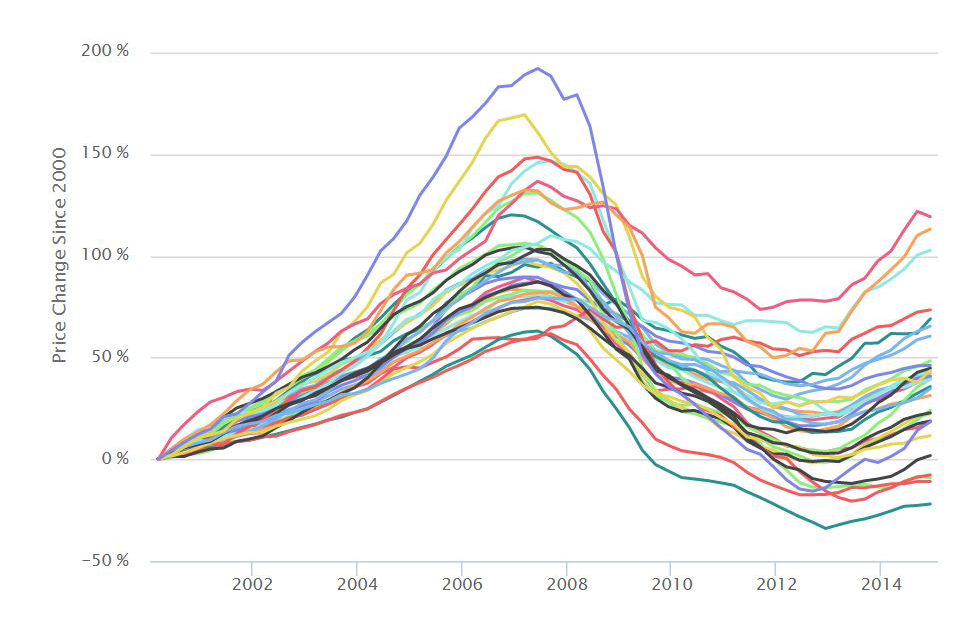 This graphic from the Institute for Housing Studies at DePaul University illustrates quarterly price trends for single family homes in 33 submarkets in the city of Chicago and suburban Cook County. An interactive graph and map are online at http://bit.ly/IHS_interactivegraph.
This graphic from the Institute for Housing Studies at DePaul University illustrates quarterly price trends for single family homes in 33 submarkets in the city of Chicago and suburban Cook County. An interactive graph and map are online at http://bit.ly/IHS_interactivegraph.CHICAGO — As house prices rebound in all communities across Cook County, the divide between areas that are thriving and those that are struggling persists, according to the May 13 release of the Cook County House Price Index from the Institute for Housing Studies at DePaul University. This release of the Index tracts quarterly price trends for typical, non-distressed single family homes in 33 Cook County submarkets from 1997 through the fourth quarter of 2014.
Findings from the institute’s new Cook County House Price Index show that the average submarket in Cook County has seen prices of single family homes increase by 18 percent as of the fourth quarter of 2014 since hitting the bottom of the market. The strongest recoveries have been experienced in Logan Square/Avondale and Humboldt Park/Garfield Park, both of which experienced increases of over 40 percent since reaching their respective bottom points. The slowest recovery since reaching bottom was in South Chicago/West Pullman, which has seen only a modest recovery of roughly 6 percent.
Other findings show that despite recent price recoveries in all markets, most communities are still dealing with the legacy of the foreclosure crisis. On average, prices of single family homes in Cook County communities were 30 percent lower in the fourth quarter of 2014 than they what they were at the peak of the market in early 2007. Prices in Englewood/Great Grand Crossing were 63 percent lower in the fourth quarter than at peak levels, and prices Humboldt Park/Garfield Park, despite the recent strong gains mentioned above, remain nearly 60 percent less than they were at the market peak. However, other communities in Cook County have come close to a full price recovery. Prices in Lincoln Park/Lakeview and Lincoln Square/North Center are effectively back to peak price levels.
The analysis shows the many of the hardest hit submarkets have seen no house price appreciation compared to as far back as 2000. In the average submarket, prices of single family homes have appreciated by 40 percent since 2000, but in distressed areas of south suburban Cook County, prices are well below 2000 levels. In the fourth quarter, prices in Calumet City/Harvey were 22 percent lower than they were in 2000 and in Chicago Heights/Park Forest, they were 11 percent lower.
“These recent price recoveries are encouraging, but must be considered in the context of longer term trends,” said Geoff Smith, executive director of the institute.
“While many areas, are close to achieving a full recovery from price declines experienced during the housing crisis, many other areas, particularly those on the South and West sides of Chicago and in South Cook County, have seen their housing markets set back by 15 years,” he said.
The analysis also shows that lack of long term price appreciation has implications for homeowners trying to build equity and has strong implications for an increasingly divided housing market. For example, a homeowner who purchased the average home in Auburn Gresham/Chatham in 2000 paid $85,500. As of the fourth quarter of 2014, prices of homes in Auburn Gresham/Chatham increased by less than two percent meaning the home would be worth roughly $87,000, or $1,500 more.
By comparison, a homeowner who purchased the average home in West Town/Near West side would have paid $330,000. As of the fourth quarter of 2014, that home would have appreciated by nearly 120 percent and be worth an estimated $723,000, or $393,000 more than what was paid in 2000.
“Long term price trends have implications not just for neighborhoods, but also for homeowners, their financial conditions, and their opportunities to build wealth,” said Smith. “Long time homeowners who live in struggling neighborhoods have not benefited from increased home equity built up through price appreciation.”
The Institute for Housing Studies has developed a new, hedonic price index model to provide a more stable mechanism for tracking submarket-level price trends. A hedonic model controls for factors that contribute to a property’s sale price such as the physical characteristics of the property and the property’s location relative to key amenities or disamenities. By isolating these effects, the model allows for the development of an index tracking price changes of the typical, non-distressed single family home over time and is ideal for tracking price trends at the submarket level.
The Institute for Housing Studies is a research center situated in the Real Estate Center at DePaul University. Its mission is to provide reliable, impartial, and timely data and research to inform housing policy decisions and discussions about the state of housing in the Chicago region and nationally. The institute’s work in particular focuses on affordable housing issues and understanding the changing dynamics of neighborhood housing markets.
The institute’s fourth quarter 2014 Cook County House Price Index is online at http://bit.ly/IHS4Q2014. An interactive graph highlighting trends for 33 submarkets is online at http://bit.ly/IHS_interactivegraph.
###
Source:
Geoff Smith
gsmith33@depaul.edu
312-362-5962
Media Contact:
DePaul University
Media Relations
newsroom@depaul.edu
(312) 362-8591